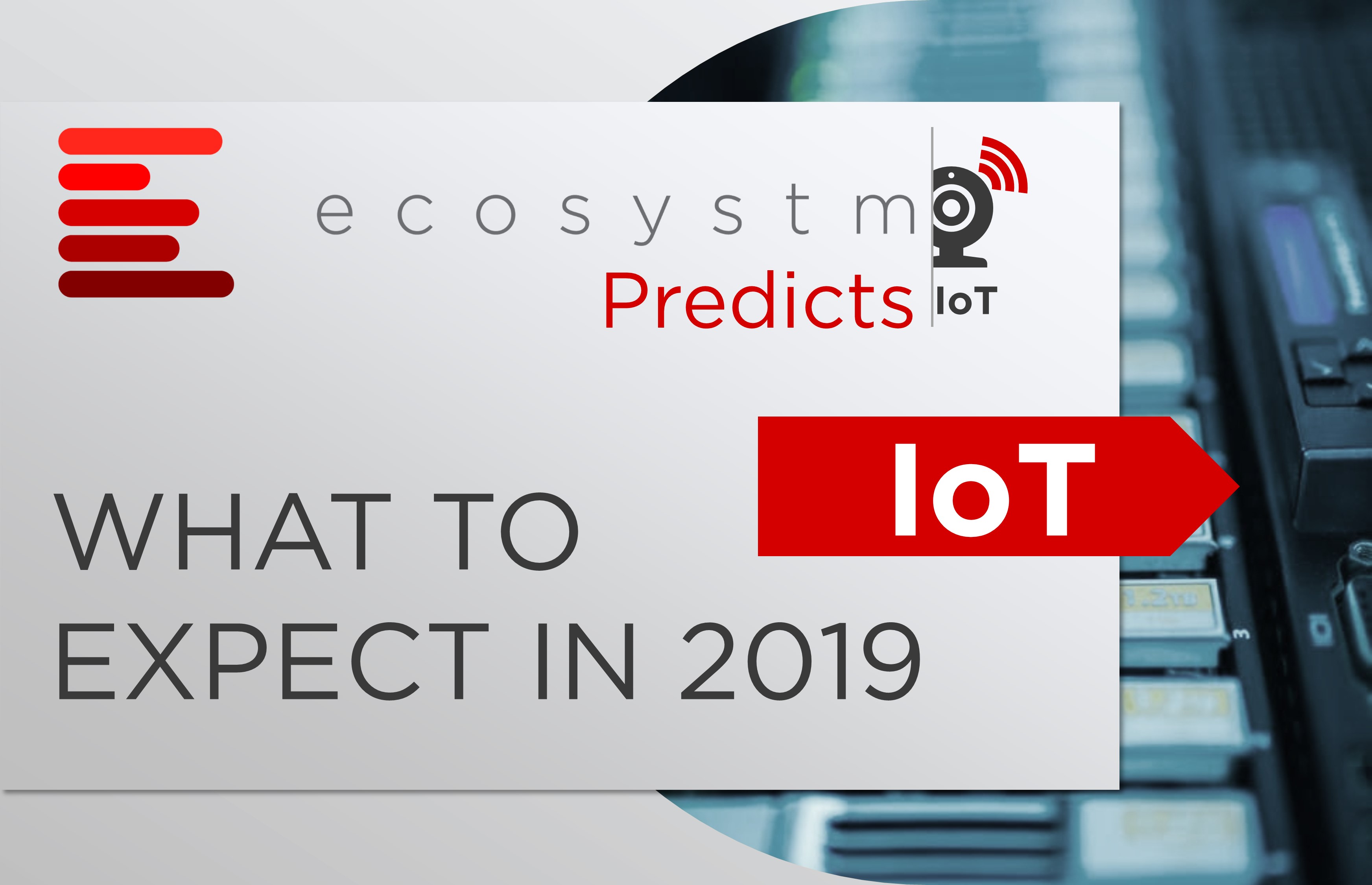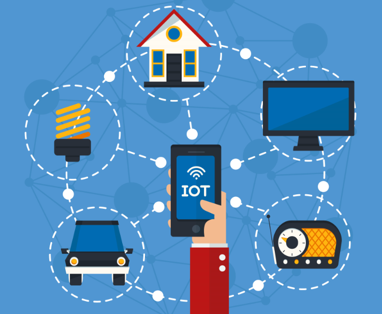A major consideration that I left for the end is whether to select an open source or a proprietary IoT Platform. The heart often wants open source, while the head chooses proprietary. It is near impossible to find someone who will deny that IoT Platforms are hot. It is not surprising that there are dozens of companies developing or updating their proprietary IoT platforms, with many of them using open source code in their products. I mention this to make it clear that probably most IoT platform vendors leverage some open source code.
Open Source IoT Platform
There are many people who believe that IoT needs open source to be successful. Everyone loves the promise of open source IoT platforms – It is free (or almost free); it is built by passionate communities of developers; and there is no vendor lock-in. Add to that, the rate of innovation, which is supposedly faster with open source IoT platforms. Why would anyone choose to work with anything else?
A while back the IoT Data Management (IoTDM) project showcased how a robust middleware platform can unlock innovation and fulfill the promise of IoT. I have been following up to 30 open source IoT platforms, starting with Eclipse Open Source IoT platforms project. Recently I have had conversations with members of a few of them such as Kaa and SiteWhere; but like I said there are many other enthusiastic IoT platform developers in the world, some closer than you think.
The advantages and disadvantages of open source have been repeated for years. On the advantages side we have:
- Cost
- Flexibility
- Avoiding cumbersome licensing requirements or activation headaches
- Freedom
However, it is not all roses in the realm of open source. As the saying goes, nothing is ever truly free. The disadvantages of open source include:
- Support
- Documentation
- Complexity
- Advertising
- Easily detectable vulnerabilities
I want to emphasize that sometimes, one of the advantages of open source – transparent, customizable code which is accessible by anyone – can be turned into a disadvantage. Without a proprietary vendor on the hook for releasing updates, fixes may be slower to arrive (though to be fair a strong developer community can develop solutions more readily as well).
Proprietary IoT Platform
If the decision to use and customize an open source IoT platform is complex, the decision to select a proprietary IoT platform is a nightmare. There are so many vendors out there that customers are expecting a market consolidation or running pilots before they can take a final purchase decision to invest in a proprietary IoT platform.
With companies like GE Digital failing with its Predix platform, the fear that any other big companies like Microsoft, AWS, Google, IBM or PTC can also fail is understandable.
And if this fear exists, you can imagine how customers feel when they need to decide among hundreds of proprietary IoT platforms guessing if they will survive or at least be acquired. You need to be careful of the Walking Dead of IoT
I have addressed the challenges and benefits of proprietary platforms in a previous blog: About IoT Platforms, Super Powers Methodology, Superheroes and Supervillains
Key Takeaway
I have repeated many times that the IoT is going to transform the way we live, work, and interact with each other. It’s more than a trend; it’s a revolution that will fundamentally transform the way the global economy functions, and IoT Platforms will play a key role.
Even after reading through this series it is possible that I may not have completely solved your doubts about what should be your decision regarding the most suitable IoT platform for your business. I hope at least you are not more confused! We should trust the market will consolidate very fast either by M&As or unfortunately by death of start-ups, so we will find a much clearer picture in a couple of years.
Nevertheless, should this fragmented market affect your decision to initiate or advance your IoT strategy? Clearly not. Your business cannot wait 2 or 3 years without IoT. Make sure that the IoT impacts you in your business – the IoT platform you choose will be key.
Thanks in advance for your Likes and Shares
Thoughts? Comments?
Industry knowledge is a key area of expertise that many organizations look for in their IoT platform vendor. The global Ecosystm IoT Study determined the key IoT partner selection criteria for planned deployments of IoT. While technical expertise emerges as the key criterion (and bodes well for horizontal platform vendors), industry expertise comes in at number 3.
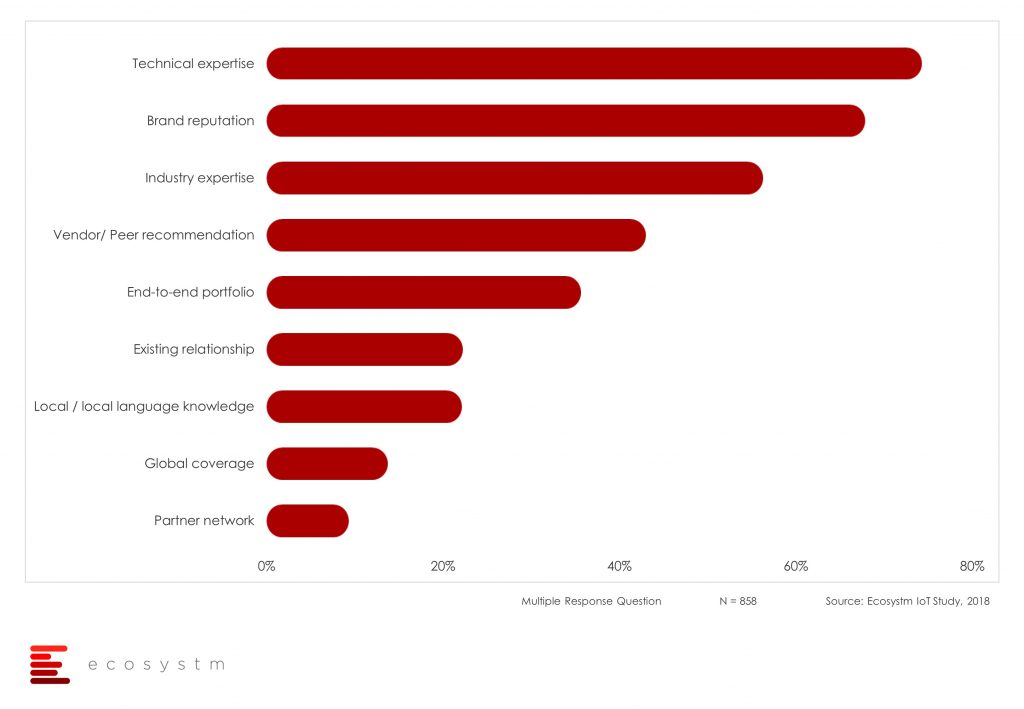
Some industries such as the Retail, Distribution & Consumer Packaged Goods, Health & Life Sciences, and Transportation assign a higher significance to industry experience.
Vertical vs. Horizontal IoT Platforms
It is not my intention to write in detail about building a vertical or horizontal IoT platform. Though I promise to address this in a detailed post later. Nevertheless, I give you two very useful links that are relevant even today. They provide different and interesting point of views.
A good example of where a horizontal platform would be beneficial is when an organization wants to leverage the portfolio of a particular vendor – let’s say connectivity to Google Cloud Platform, giving customers the benefits of using BigQuery, Google’s analytical service, using data collected from connected devices. On the other hand, a good example of a vertical platform use would be from Healthcare where the organisation chooses an integrated cloud-based, analytics-driven solution designed to deliver real-time, actionable insights on patient care across the entire patient experience.
There are always some special industry cases, as well, such as the companies that want to participate in the home automation market. In Who Will Build The ‘God Platform’ For The Internet Of Things? the author suggests that these companies will need to create products that work compellingly in isolation and alongside competitors’ products — and somewhere in all of this, the ‘God Platform’ might emerge.
The Singular Case of Smart City Platforms
Smart Cities need Intelligent Platforms to thrive. IoT will be central to this shift from a vertical to horizontal approach, based around a new generation of powerful, unified Smart City Platforms, capable of managing different technologies and devices and supporting a wide range of applications and services. A Smart City Platform is defined as a framework for sensing, communications, integration and intelligent decision-making, delivering the minutest information and services that citizens need.
Some Other Considerations
Platforms Vs. Products
We hear IoT vendors saying that the IoT is at an inflection point. In “The Internet Of Things Race – Platforms Vs. Products”, Adrian Bridgwater raises an interesting discussion. What matters most, the platforms or the products?
“What does matter is the degree to which we recognize just how much the Internet of Things (IoT) platform-level technologies matter. We need analytics tools capable of dealing with large quantities of fast-moving data, we need cloud Platform-as-a-Service functionality that is capable of handling the immense flow of data and provide anytime access for decision and we need security systems capable of helping organizations protect IoT data as rigorously as they do their own confidential financial, IP and strategy information”.
For Adrian, today, it’s the Internet of Things (IoT) but tomorrow it will be the Internet of Analytics-Enabled Secure Automated Wearable Things (IoA-EASWT).
Platforms Vs. Frameworks
Lots of IoT frameworks and/or platforms with different enterprise offerings and alliances have come up recently to increase the connectivity of devices into private and/or public networks/cloud. Key to a successful IoT implementation is the interoperability among various devices, robust IoT frameworks and platforms that enable the same with powerful analytics that enable applications to be built on top of it.
Historically I had been responsible for drafting predictions that were often discrete and almost independent of each other. However, in the last 12 months I’ve become a strong proponent of observing market trends and joining their collective impact into bigger and broader industry predictions. I feel that this approach has more value to the ecosystem, that takes to enable the Internet of Things.
With this as a backdrop, my five independent predictions are aimed at vendors and customers to be constantly reevaluating their position in the value chain with adjacent technologies and markets. The predictions for 2019 are:
- Flexibility Will Outweigh Performance: eSIM and MVNOs Will Create More IoT Services Value than 5G Providers.
- The Intelligent Edge and SD-WAN Will Tackle the Distributed Network Performance and Management Issues.
- IoT Ecosystems Will Evolve into Automated, Intelligent and Interactive Workspaces.
- IoT Public and Private Market Exchanges Will Emerge Enabling AI-Based Startups to Create Business Outcome Services.
- The Insurance Industry Will Become the Leading Advocate for IoT Innovation Services Forcing ICT Companies to Play Along.
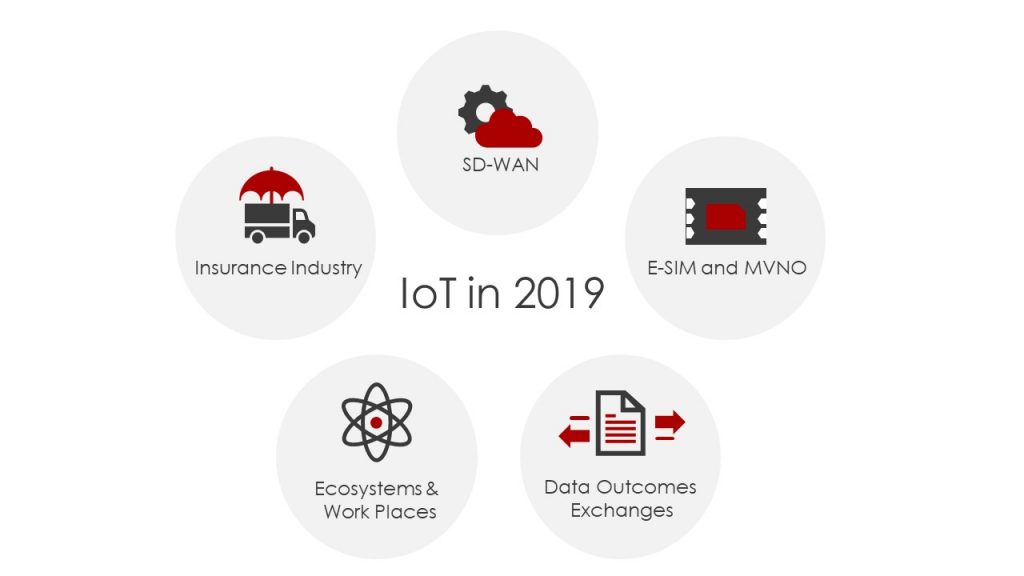
At the base of the predictions pyramid, or a starting point in an IoT ecosystem where the customer or their data is in the center, is connectivity. The deafening drum beat of 5G can be heard. By all accounts every IoT application should be deployed onto a 5G network in 2019. However, while 5G and several key IoT applications are a great fit for each other (video is a perfect example), customers are already testing alternatives which are both good enough from a network performance and business case angles. To that end, 2019 will be a year where e-SIMs delivered by Mobile Virtual Network Operators (MVNOs) will be the defacto on-ramp for many ICT organizations. Layered upon that will be the opportunity to run unlicensed spectrum such as LoRa to greatly simplify the complex issue of connectivity, security and scalability.
As more customers scale up their IoT deployments in 2019, distributed architectures become more important as edge computing takes on the new ‘branch office’ layer. To respond to the new network edge, distributed networks become easier to manage with the broader deployment and acceptance of software-defined wireless access networks (SD-WANs). SD-WANs will become the stepping stones for carriers, network equipment vendors, IT and industrial operations to deliver application management performance, and security.
In 2019 the discussion of who has the best IoT platform will become irrelevant, as customers who own the IoT data will be asking who has the best ecosystem. IoT data will quickly shift business processes from being stand-alone engagements between suppliers and customers to one of a complete end-to-end solution. Industries such as manufacturing, retail, smart buildings, smart cities, transportation and logistics will all come alive with disruptive business models and services within the ecosystem. This shift will generate a ‘new software’ platform that isn’t owned by a traditional IT software company, but by someone who owns the business relationship with the customer and who can aggregate all of the players onto the platform.
These automated, intelligent and interactive workspaces will become a potential battleground between traditional services companies and these new nimble aggregators using SaaS-based platforms to deliver better customer experiences. By late 2019, these ecosystems will become the foundation layer for IoT exchanges whereby business knowledge gained from IoT analytics will be traded or bartered within private or public exchanges. Here, technology such as blockchain will have a very relevant place within IoT solutions.
Finally, in 2019 the major insurance companies will rise to become some of the most influential players in making vendors and customers adopt IoT solutions. Knowing that IoT sensors can give detailed information on every aspect of product and customer behavior, insurance companies will exercise pressure on everyone who wants to play within an IoT ecosystem. Anyone who wants or needs some level of product warranty, liability, replacement coverage, service and user behavior insurance will be impacted by IoT-fed actuary tables. Insurance underwriters will ask, seek or have the ability to combine IoT data with Artificial Intelligence (AI), and Machine Learning (ML) integrating the outcomes with Augmented Reality (AR), Digital Twins and 3D-Printing for robotics, drones, autos (or all levels of transportation) across every industry. The influence and impact will be significant and to every intersection of technology and human interface as the high demand for data drives IoT sensor deployment from the base of the network infrastructure all the way to the ecosystem and exchanges.
For access to the full report, please follow this link.
In this instalment we explore how commercially available platforms, including M2M platforms, might be an option for you.
Once Upon a Time – A Small Group of M2M Platforms
M2M Service Providers have been using the term M2M Platform for years with their enterprise customers. The main functionality of these carrier-grade platforms was to manage connectivity through a secure, fast and reliable private network via dedicated hubs directly into each of the major network partners. They allowed control of multiple network SIM estates, management of SIMs and devices and finally management of their billing administration in line with their own systems and procedures.
Most M2M Service Providers developed in-house M2M platforms but also in parallel they acquired M2M platforms from vendors such as Cisco Jasper Control Center, Ericsson Device Connection Paltform (DCP) , Cumulocity, and Telenor Connexion , among others.
With the hype around IoT, M2M Service Providers become more interested in offering their enterprise customers an IoT application development environment that can reduce time, cost, and complexity of deployment of solutions, that can optimize their business processes and help them deliver better and faster services. An early example was Etisalat leveraging ThingWorx IoT Development Platform, announced in 2015.
Which brings me to a mobile network operator (MNOs) – Can they avoid the temptation to develop their own IoT management and application platforms? The complexity of IoT value-added service (VAS) development and deployment demands a continuing operational and commercial effort.
My recommendation: MNOs should instead consider partnering with well-established technology vendors in order to accelerate time to market and create customer value through innovation.
Buy or Build an IoT Platform – Making the Right Decision
Technology companies have spent years adapting their sales pitch to convince their customers or potential customers of the advantages of buying commercial products or ultimately IaaS, PaaS or SaaS platforms. On the other hand, many companies across industries see a risk that their business will depend on suppliers and fear being captives of these technology providers. Their management team and tech leaders have found enough arguments to develop their solutions from scratch.
The eternal dilemma, whether to build from scratch or buy a commercially available off-the-shelf (COTS) IoT Platform to support the needs of the enterprise will continue for a while. Here’s what you need to know about both approaches before making this critical project decision.
- Step 1: Validate the need for an IoT platform. Focus on validating that a business need exists prior to deciding and estimate the return on investment (ROI) or added value.
- Step 2: Identify core business requirements – Involve the right business people. This will determine the success of the process.
- Step 3: Identify architectural requirements – It is extremely important to identify any architectural requirements and follow the status of the confusing IoT standards world, before determining if a COTS or custom solution is the best choice.
- Step 4: Examine existing IoT Platforms – At this point, a business need has been pinpointed, ROI has been estimated, and both core business and architectural restrictions have been identified. Now, you should take a good look at existing IoT vendors (a short list of IoT platforms, to be more concrete).
- Step 5: Evaluate your in-house skills to support a custom IoT platform – It takes many skills to design and deploy a successful IoT platform that is both scalable and extensible.
- Step 6: Explore if a COTS IoT platform fits your need – If your organization does not include a development group comprising personnel experienced in designing IoT solutions to support your enterprise-wide business solutions, a COTS IoT platform will probably provide the best long-term ROI.
More considerations for choosing an IoT platform coming up in the next
When I published “It’s an IoT Platform, stupid!” in 2015 , I did not think that it would be one of my most visited and shared articles. I am proud that just in LinkedIn, this article has received more than 8,000 visits. That´s why I have chosen an update of that article to initiate my collaboration with Ecosystm.
When in late 2013, I decided to relaunch my company OIES Consulting with a focus this time on Advisory services for Internet of Things (IoT), I thought the selection of IoT platforms would be one of the most useful services that we would offer and certainly one that would bring more benefits to the clients wishing to accelerate the adoption of IoT.
At that time, I had identified about 60 IoT platform vendors and despite guidance from research firms, the confusion was brutal. Today it is worse – there are more than 600 platform vendors and the expected market consolidation still has not arrive. Like other analysts and bloggers, I tried to maintain, classify and publish a list of IoT platform vendors but it looks like an impossible task. However, it is a matter of 2-3 more years.
You must agree with me that the IoT platform market needs a quick and urgent consolidation. Hopefully, in the magical year of 2022, we will be talking about no more than 50 vendors at the most.
The Confusing Market of IoT Platforms
But first things first. How to define an IoT platform? How to differentiate between a Connected Device Platform (CDP) and an Application Enablement Platform (AEP) and an IoT Middleware and a Service Enablement Services (SES) platforms?
“Not All IoT Platforms are Created Equal”, it has been said before, and we must understand that the current generation of IoT platforms probably represent the first iteration in this space. But there are marked differences between the different types of platforms. As an organization looking to embrace an IoT platform, this initial diversity can result very confusing. Sean Lorenz from Xively rightly said that the “IoT Platform” is such an overloaded term that its meaning has been lost. Chipset manufacturers, sensor manufacturers, software vendors, consortia and system integrators all have their own definitions.
We find out there with a large number of companies that offer us IoT platforms in the cloud or on premises; for horizontal or vertical implementations; for embedded software development or industrial applications development; with data capture and real-time analytics capabilities; with devices and protocols management capabilities; with connectivity to any network; for developing applications for smart homes, for smart cities, for connected vehicles, for wearables….. the list continues! Tech buyers are understandably confused in their choice of IoT platform. The global Ecosystm IoT Study reveals this confusion.
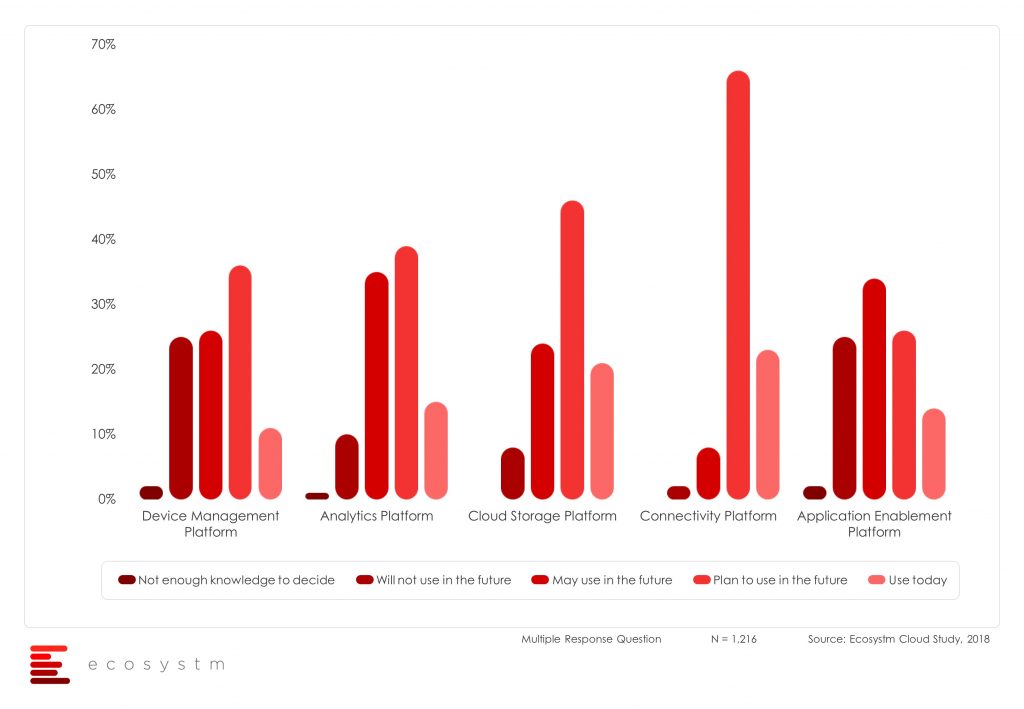
In such circumstances it is preferable to avoid arguments about which is an IoT platform and how we categorize them. My recommendation here is to ask for help from specialized IoT consultants. They will be able to give you specific guidance based on present and future business needs and can help in the IoT platform selection.
Over my next few blogs I will attempt to guide you through the significance of the different kinds of platforms. It will surely help you in your IoT platform choice, keeping the needs and capabilities of your business in mind.
Stay tuned!
There have been several productivity improvement techniques such as Kaizen, Total Quality Management (TQM), Business Process Reengineering (BPR), Lean Manufacturing, Lean Thinking, Lean Maintenance, Six Sigma, ISO Certifications and Business Process Management and others. These waves of productivity improvements focused on certain core principles such as:
- Cutting waste from processes
- Bringing transparency to decision-making
- Empowering users through better involvement and cross-functional information
- Improving quality, cutting costs, improving business velocity and improving customer satisfaction
These productivity improvement initiatives provided incremental benefits to the industries where they were implemented. However, companies often were satisfied with the marginal benefit they could manage to derive from their business improvement initiatives.
How Productivity Improvement and Enterprise Software Solutions are Implemented?
In the last 20 years, enterprise solutions like ERP, SCM, HCM, and CRM were at the forefront of digitising business processes. Many companies have tried to implement these solutions without a thorough analysis of achieving real business outcomes and deviations from current business models. As a result, there have been many cases of wasted investment and time, where software solutions have been implemented with little to no additional gains.
To eliminate the risk of such technology implementations, while at the same time better manage the projects, an array of implementation methodologies has been designed by consultants. Positive collaboration between a company and its consulting partners yields positive results. However, such high-level revamping of business models has not been considered mainstream in traditional industries.
Startups on the other hand have experimented with new business models. We have all seen the emergence of new industries such as eCommerce and eGovernment and new initiatives such as Online Advertising, Mobility Apps, and Internet Banking. In many ways, these industries have brought significant changes in our life. In the coming era, we perceive the need to bring changes in the business model in conventional industries.
Emergence of IoT for Process Improvements
One of these new technologies companies are implementing is Internet of things (IoT). Many companies are considering the implementation of IoT solutions in a variety of different ways. These companies need to justify their projects and apply deep thinking for value creation. To bring process value, we need to answer questions such as:
- What is the purpose of a process?
- Can we eliminate it? If not, can we simplify it?
- Can we do the process in a better way?
- Can we improve the quality of product, process and relationships?
- How can my processes add better value to the company?
- Can I create better outcomes?
- Can I implement IoT now and create a differentiator?
IoT in a true sense is much beyond the installation of sensors on products, equipment, locations and people. IoT includes a myriad of solutions such as asset tracking, predictive maintenance, remote diagnostics, chatbots, drones, machine learning and artificial intelligence – the list is almost endless. In a fully-fledged IoT implementation, machine-to-machine communications would be used to eliminate human errors and provide rapid decision-making. The challenges of IoT entail integrating multiple partner’s product stacks into your solution while keeping it seamless for your end-user.
IoT implementations are iterative in nature and therefore the best implementation practices have yet to be evolved. We have formulated methodologies that trigger value creation validation at every stage of the methodology i.e. from the Ideation Stage to the Deployment stage. We need to create the value not in terms of incremental benefits but also changing the business model of the company itself. Start-ups challenge traditional giants not by evolving incrementally but by providing revolutionary new advancements. New business models would need to be delivering improved value to the customers in a much more personalised manner. New business models will need to address new pricing strategies as well as new positioning, new partnerships, new order fulfillment structures and new modes of customer value delivery.
Rethinking Business Models
Companies need to seriously think about an IoT project as a strategic initiative. IoT can immensely help companies in deploying creative ways to become efficient. IoT implementations cannot be approached the same way as a software implementation. In an IoT project implementation methodology we would not only focus on processe improvement and cutting waste, but we would also ask fundamental questions about the way relationships are maintained with the customers and within the company. While implementing an IoT solution, we need to make sure that we have answered some tough questions regarding our business. Secanarios such as this could arise:
Currently a train manufacturer sells trains to the railways. Railways then become the equipment owner with full responsibility of operating and maintaining the trains. The railway’s real job is to transport people from one place to another. However, a huge chunk of resources is spent in maintaining the trains and assuring high reliability. With IoT, the maintenance may be outsourced to the equipment manufacturer. All operations and maintenance data is captured in the system and the equipment manufacturer is a party to providing reliable service. With the maturity of technology and acceptance, a time will come when railways will ask, “What is my real business? Is it operating trains or is it maintaining trains? Can we collaborate with the equipment manufacturer to maintain the train? How do I know that the equipment manufacturer can do the right job and assure high reliability?”
These questions are difficult to answer because of the separate value models assigned to the ecosystem partners. However, IoT technology is changing business boundaries. Train manufacturers and train operators can now start thinking of offering new business models by remotely predicting and diagnosing faults. Over a period of time, with trust having been established, railways and train manufacturers can even think of changing their pricing model based on the number of passengers being carried, or distance travelled with incorporated reliability standards.
This is a simple model in which an IoT product enables value creation through closer relationships between supplier and customer, and by rethinking the ways current business models need to be tweaked. When we design the new business models, we should surely ask some relevant questions like:
- Is my IoT business model cutting costs, improving productivity, improving user motivation and/or increasing revenue?
- How are new delivery models eliminating or reducing inefficiencies?
- How am I collaborating with the players I never thought of collaborating with earlier?
The future holds a new era of high productivity. Moreover, a plethora of new industries will naturally sprout with the emergence of new business models created due to technologies such as IoT. Companies should closely focus on value creation using new business models and align all resources as required by the new business model.




